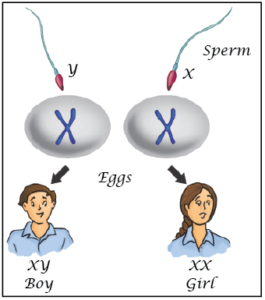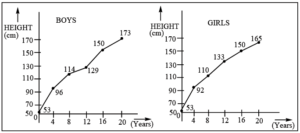NCERT Solutions for Science Chapter 10 in Class 8 – Free PDF Download
Students learn about adolescence, changes in adolescence, and hormones in adolescence, sexual maturation in boys and girls, and menstrual cycles in Class 8 Science Chapter 10. Puberty, sexual characteristics, the roles of hormones in females, sex determination, and reproductive health are among the subjects covered in Ch 10 Science Class 8.
For Reaching the Age of Adolescence Class 8, INFINITY LEARN delivers free insight and information. The teaching staff is highly qualified, with a focus on effective teaching skills.
You can also get NCERT Solutions for Class 8 Maths to help you revise the entire syllabus and get better grades in your exams.
CHAPTER 10_REACHING THE AGE OF ADOLESCENCE NCERT SOLUTIONS
1.What is the term used for secretions of endocrine glands responsible for changes taking place in the body?
A. Hormones.
2.Define adolescence.
A. The period of life, when the body undergoes changes, leading to reproductive maturity is called adolescence.
3. What is menstruation? Explain.
A. The cycle of changes that occur in female reproductive system once in every 28-30 days is called menstrual cycle.
i) The uterine wall in females prepares itself to receive the developing fertilised
ii) In case there is no fertilisation, the thickened lining of the uterine wall breaks down and goes out of the body along with blood. This is called menstruation.
iii) Menstruation occurs once in about 28 to 30 days.
iv) The first menstrual flow begins at puberty and is termed as menarche.
v) The menstrual cycle stops at the age of 45 to 50 years. This is termed as
4. List changes in the body that take place at puberty.
A. i) Sudden increase in height.
ii) Change in body shape.
iii) Change in voice.
iv) Increased activity of sweat and sebaceous glands.
v) Appearance of secondary sexual characteristics.
5. Prepare a table having two columns depicting names of endocrine glands and hormones secreted by them.
A.
| S.No. | Name of the Endocrine gland | Hormones secreted |
| i) | Pituitary | Growth Hormone |
| ii) | Thyroid | Thyroxine |
| iii) | Adrenal glands | Adrenaline |
| iv) | Pancreas | Insulin |
| v) | Testes | Testosterone |
| vi) | Ovaries | Estrogen, Progesterone |
6. What are sex hormones? Why are they named so? State their function.
A. i) The hormones that stimulate the development of the secondary sexual characters are called sex hormones.
ii) As they regulate the growth and function of reproductive organs they are called sex hormones.
iii) Sex hormones stimulate changes in the body at onset of puberty.
7. Choose the correct option.
a. Adolescents should be careful about what they eat, because : ( ii )
i) proper diet develops their brains.
ii) proper diet is needed for the rapid growth taking place in their body
iii) adolescents feel hungry all the time.
iv) taste buds are well developed in teenagers.
b. Reproductive age in women starts when their : ( i )
i) menstruation starts ii) breasts start developing
iii) body weight increases iv) height increases
c. The right meal for adolescents consists of : ( ii )
i) chips, noodles, coke
ii) chapati, dal, vegetables
iii) rice, noodles and burger
iv) vegetable cutlets, chips and lemon drink
8. Write notes on :
a) Adam’s apple.
b) Secondary sexual characters
c) Sex determination in the unborn baby
A. a) Adam’s apple : The growing voice box in boys can be seen as a protruding part of the throat (Larynx) called Adam’s apple.
i) At puberty, the voice box or the larynx begins to grow. Boys develop larger voice boxes.
ii) In girls, the larynx is hardly visible from the outside because of its small size. Generally, girls have a high pitched voice, whereas boys have a deep voice.
b) Secondary Sexual Characters : The characters or features which help to distinguish the male from the female are called secondary sexual characters.
Eg : Change in pitch of voice, characteristic hair growth etc.
c) Sex determination in unborn baby :
i) The sex of a baby is determined by the type of male gamete that fuses with the female gamete.
ii) All human beings have 23 pairs of chromosomes in their nuclei. Out of these 23 pairs, the last pair is known as the sex chromosomes.
iii) The human males have 23 pairs of chromosomes including XY sex chromosomes.
iv) Therefore, the male gamete has 22 Autosomes and either X or Y sex
v) Male gametes can be of two types : 22 + X or 22 + Y.
vi) Females have 23 pairs of chromosomes including XX sex chromosomes. Therefore, their gametes can only have 22 Autosomes and one X sex chromosome. Type of female gametes: 22 + X.
vii) Thus, as the mother provides only X chromosome, the sex of the baby is determined by the type of male gamete (X or Y) that fuses with the X chromosome of the female.

9.Word game : Use the clues to work out the words.
Across : Down :
3.Protruding voice box in boys 1. Male hormone
4.Glands without ducts 2. Secretes thyroxine
7.Endocrine gland attached to brain 3. Another term for teenage
8. Secretion of endocrine glands 5. Hormone reaches here through blood stream
9. Pancreatic hormone 6. Voice box
10. Female hormone 7. Term for changes at adolescence

A.

10.The table below shows the data on likely heights of boys and girls as they grow in age. Draw graphs showing height and age for both boys and girls on the same graph paper. What conclusions can be drawn from these graphs ?

A.

Conclusion :
i) Boys grow faster than girls from 0 to 8 years.
ii) Girls grow faster than boys from 8 to 12 years.
iii) But at the age of 16 years both reach their maximum height.
iv) After the 20 years of age boys shows more height than girls.
NCERT Solutions for Class 8 Science Chapter 10 – Adolescent Development
Class 8 Science Chapter 10 NCERT Solutions – Free PDF Download
Adolescence is the main emphasis of NCERT Class 8 Science Chapter 10. Adolescence is the most essential period of a person’s life when it comes to physical and mental development. Teenagers go through a lot of physical changes throughout this time. Teenagers improve their fundamental reproductive traits and capacities during this period.
The NCERT solution for Class 8 Science Chapter 10 is available in PDF format and is free to download. Explanatory questions, answers, diagrammatic representations, MCQs, graphical representations, and notes on various themes are all included in the PDF of NCERT solutions for Class 8 Science Ch 10 created by an esteemed team of teachers.
The appropriate way to teaching such a significant chapter on adolescents is critical in helping kids in class 8 develop the right mindset.
INFINITY LEARN’s website is the best spot to go if you’re looking for Reaching the Age of Adolescence Class 8 PDF.
Chapter 10 of Science for Class 8 Adolescence is a stage in life when a person reaches the age of puberty.
Adolescence is a period of considerable physical and mental development. This is the stage at which an individual’s biological maturation occurs. In teenagers, biological maturation leads to specific psychological and social changes. For a teenager’s development to be properly shaped, sufficient direction is essential.
NCERT answers Class 8 Science Chapter 10 is divided into several sub-topics, including as
- Adolescent years
- Puberty
- Qualities of sexuality
- Hormones play a role in reproductive functioning.
- Determining sex
- Reproductive health’s significance
The period of adolescence has been labelled as the “era of adrenaline rushes.” Teenagers are at a stage in their lives where they require extra attention from their parents or guardians. A teenage boy or girl’s mental and physical characteristics change dramatically as they approach puberty. This is mostly due to puberty’s control on both psychological and physical development. Adolescence is a period when a teenager’s physical characteristics undergo substantial changes.
Students can use the NCERT answers for Reaching the Age of Adolescence Class 8 to learn about healthy and safe reproductive health. INFINITY LEARN’s team of teachers has paid close attention to these details.
NCERT answers for Class 8 Science Chapter 10 have a number of advantages.
NCERT solutions for Class 8 Science Chapter 10 from INFINITY LEARN are created by an expert team of teachers using the most up-to-date NCERT standards and syllabus.
The following are some of the advantages of using NCERT Science Class 8 Chapter 10 solutions:
- INFINITY LEARN has made NCERT solutions for Class 8 Science Chapter 10 Reaching the Age of Adolescence free, easy to download or read on its website in order to make education more accessible and available.
- The NCERT Class 8 Science Chapter 10 Solutions PDF contains instructions for drawing diagrammatic representations from the Adolescence, Reproductive Parts chapter.
It also includes questions and answers, as well as multiple-choice questions and matching the following.
- The accompanying PDF will provide brief explanations on subtopics such as puberty and adolescence, male and female sexual characteristics, hormone roles in early reproductive activities, and reproductive health.
INFINITY LEARN’s online NCERT solutions for Class 8 Science Chapter 10 are a terrific option if you’re still looking for approaching the Age of Adolescence Class 8 solutions PDF.



